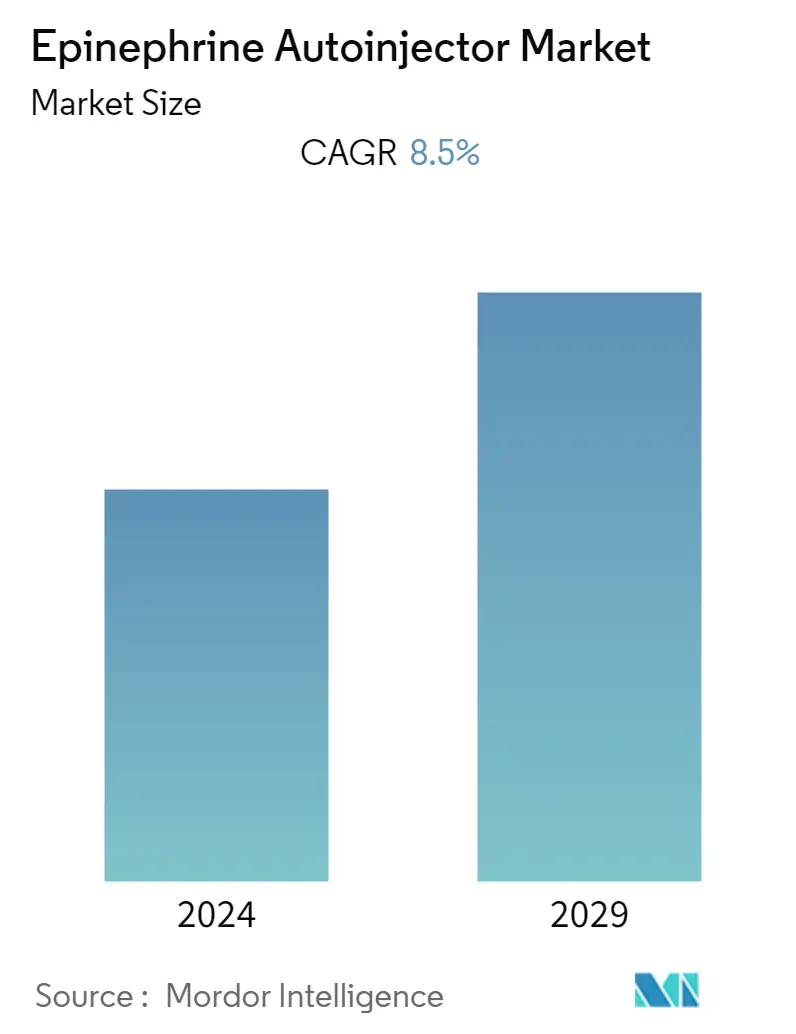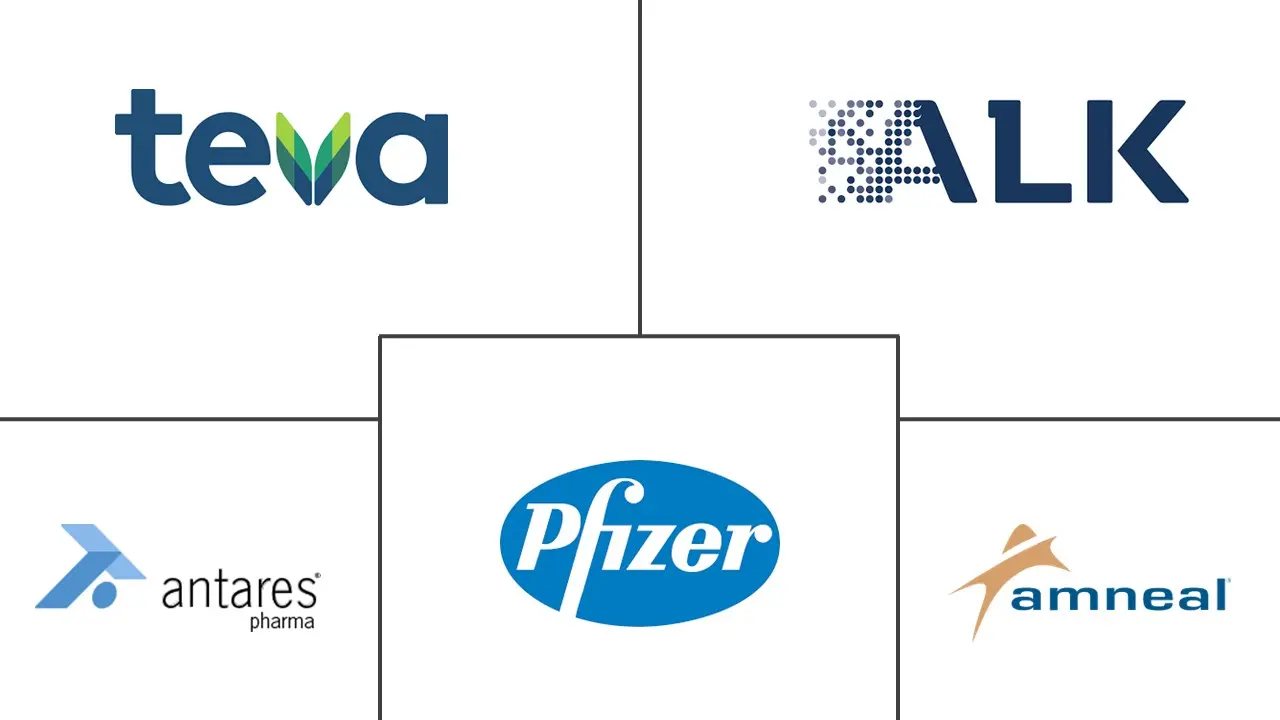Market Size of Epinephrine Autoinjector Industry

| Study Period | 2019 - 2029 |
| Base Year For Estimation | 2023 |
| CAGR | 8.50 % |
| Fastest Growing Market | Asia-Pacific |
| Largest Market | North America |
| Market Concentration | Medium |
Major Players
*Disclaimer: Major Players sorted in no particular order |
Epinephrine Autoinjector Market Analysis
The epinephrine autoinjector market is expected to register a CAGR of 8.5% over the forecast period.
The COVID-19 pandemic had a substantial impact on patients with any disease, the prevalence of allergic diseases showed heterogeneous patterns during the COVID-19 pandemic, and epinephrine autoinjectors helped the patients to combat its effect. The rising adoption of epinephrine autoinjectors during the COVID due to severe allergic reactions reported after the administration of COVID-19 vaccines is expected to contribute to the growth of the market during the pandemic period. For instance, the FDA's October 2020 update and the Centers for Disease Control and Prevention (CDC) guidance entitled 'Emergency Use Authorization for Vaccines to Prevent COVID-19's state that if an acute anaphylactic reaction occurs after the administration of a COVID-19 vaccine, the administering facility should always have at least 3 doses of age-appropriate epinephrine available, as well as the ability to quickly obtain additional doses to replenish supplies after epinephrine runs out.
The rise in availability of several versions of products, innovative drug administration techniques that match the demands of patients, increasing awareness about self-administration, and adoption of more expensive auto-injectors over traditional injecting methods, as well as enhanced healthcare infrastructure, are among the major factors driving the growth of the studied market. Furthermore, favorable reimbursement policies in developed countries are anticipated to fuel the growth in the market.
According to World Health Organization reports, over 16 billion injections were administered annually worldwide in 2021, stimulated by the increasing number of injections administered boosting the autoinjector market. As a result, the global epinephrine autoinjector market is anticipated to develop in the future due to the convenience of use and disposal of drug injectors and the acceptance of autoinjectors, which are positioned to accelerate market expansion for the researched industry throughout the projected period.
In addition, new product launches and strategic activities, such as mergers/acquisitions, recent developments, joint ventures, collaborations, and partnerships by major players in the market are positively affecting the growth of the studied market. For instance, Catalent scheduled to manufacture a new batch of SYMJEPI in November 2022, for Adamis Pharmaceuticals Co. in Belgium, anticipating the relaunch of SYMJEPI and commercial availability before the end of the first quarter of 2023.
Therefore, owing to the aforementioned factors the studied market is anticipated to witness growth over the analysis period. However, regulatory constraints and the inflated cost of epinephrine autoinjectors are likely to impede the market growth.
Epinephrine Autoinjector Industry Segmentation
As per the scope of the report, epinephrine autoinjectors are hand-held medical devices that deliver doses of epinephrine or adrenaline to treat anaphylaxis or other severe, life-threatening allergic responses brought on by insect bites, medications, or stings.
The epinephrine autoinjector market is segmented by Dosage (0.15 mg, 0.30 mg, and 0.50 mg), Age-group (0 to 6 Years, 6 to 12 Years, and over 12 Years), End-User (Hospitals, Clinics, and Home-based), and Geography (North America, Europe, Asia-Pacific, Middle East & Africa, and South America). The market report also covers the estimated market sizes and trends for 17 different countries across major regions, globally. The report offers the value (in USD million) for the above segments.
| By Dosage Type | |
| 0.15 mg | |
| 0.30 mg | |
| 0.5 mg |
| By Age-group | |
| 0 to 6 Years | |
| 6 to 12 Years | |
| Over 12 Years |
| By End-User | |
| Hospitals | |
| Clinics | |
| Home-based |
| By Geography | ||||||||
| ||||||||
| ||||||||
| ||||||||
| ||||||||
|
Epinephrine Autoinjector Market Size Summary
The epinephrine autoinjector market is poised for significant growth, driven by several key factors. The COVID-19 pandemic highlighted the importance of these devices, as they became crucial in managing severe allergic reactions following vaccine administration. This increased adoption during the pandemic period is expected to contribute to the market's expansion. The market is further bolstered by the availability of various product versions, innovative drug administration techniques, and heightened awareness of self-administration. The shift towards more advanced and expensive autoinjectors over traditional methods, coupled with improved healthcare infrastructure and favorable reimbursement policies in developed countries, is also propelling market growth. Strategic activities such as mergers, acquisitions, and new product launches by major players are positively influencing the market dynamics, despite challenges like regulatory constraints and high costs.
North America is anticipated to hold a substantial share of the global epinephrine autoinjector market, supported by easy product availability, the launch of generic substitutes, and a rising incidence of anaphylaxis. The region's market growth is further fueled by the increasing need for quick emergency responses and the presence of key market players. The competitive landscape is characterized by a few established vendors, including Adamis Pharmaceuticals, Alk-Abello, and Sanofi, among others, who dominate the market. Recent developments, such as FDA approvals and innovative product launches, underscore the market's dynamic nature. The ongoing demand for new therapeutics and continuous product advancements are expected to sustain the market's growth trajectory over the forecast period.
Epinephrine Autoinjector Market Size - Table of Contents
-
1. MARKET DYNAMICS
-
1.1 Market Overview
-
1.2 Market Drivers
-
1.2.1 Advent of Cost-Effective and Robust Generic Epinephrine Autoinjectors
-
1.2.2 Increasing Awareness about Self-Injection with First-Line of Treatment
-
1.2.3 Rise in Incidences of Anaphylaxis and Food Allergies
-
-
1.3 Market Restraints
-
1.3.1 High Cost of Autoinjectors and Multiple Alternatives for Injections
-
-
1.4 Industry Attractiveness - Porter's Five Force Analysis
-
1.4.1 Threat of New Entrants
-
1.4.2 Bargaining Power of Buyers/Consumers
-
1.4.3 Bargaining Power of Suppliers
-
1.4.4 Threat of Substitute Products
-
1.4.5 Intensity of Competitive Rivalry
-
-
-
2. MARKET SEGMENTATION (Market Size by Value - USD Million)
-
2.1 By Dosage Type
-
2.1.1 0.15 mg
-
2.1.2 0.30 mg
-
2.1.3 0.5 mg
-
-
2.2 By Age-group
-
2.2.1 0 to 6 Years
-
2.2.2 6 to 12 Years
-
2.2.3 Over 12 Years
-
-
2.3 By End-User
-
2.3.1 Hospitals
-
2.3.2 Clinics
-
2.3.3 Home-based
-
-
2.4 By Geography
-
2.4.1 North America
-
2.4.1.1 United States
-
2.4.1.2 Canada
-
2.4.1.3 Mexico
-
-
2.4.2 Europe
-
2.4.2.1 Germany
-
2.4.2.2 United Kingdom
-
2.4.2.3 France
-
2.4.2.4 Italy
-
2.4.2.5 Spain
-
2.4.2.6 Rest of Europe
-
-
2.4.3 Asia-Pacific
-
2.4.3.1 China
-
2.4.3.2 Japan
-
2.4.3.3 India
-
2.4.3.4 Australia
-
2.4.3.5 South Korea
-
2.4.3.6 Rest of Asia-Pacific
-
-
2.4.4 Middle East & Africa
-
2.4.4.1 GCC
-
2.4.4.2 South Africa
-
2.4.4.3 Rest of Middle East & Africa
-
-
2.4.5 South America
-
2.4.5.1 Brazil
-
2.4.5.2 Argentina
-
2.4.5.3 Rest of South America
-
-
-
Epinephrine Autoinjector Market Size FAQs
What is the current Epinephrine Autoinjector Market size?
The Epinephrine Autoinjector Market is projected to register a CAGR of 8.5% during the forecast period (2024-2029)
Who are the key players in Epinephrine Autoinjector Market?
ALK-Abelló A/S, Amneal Pharmaceuticals, Inc., Antares Pharma, Inc., Pfizer Inc. and Teva Pharmaceutical Industries Ltd. are the major companies operating in the Epinephrine Autoinjector Market.

